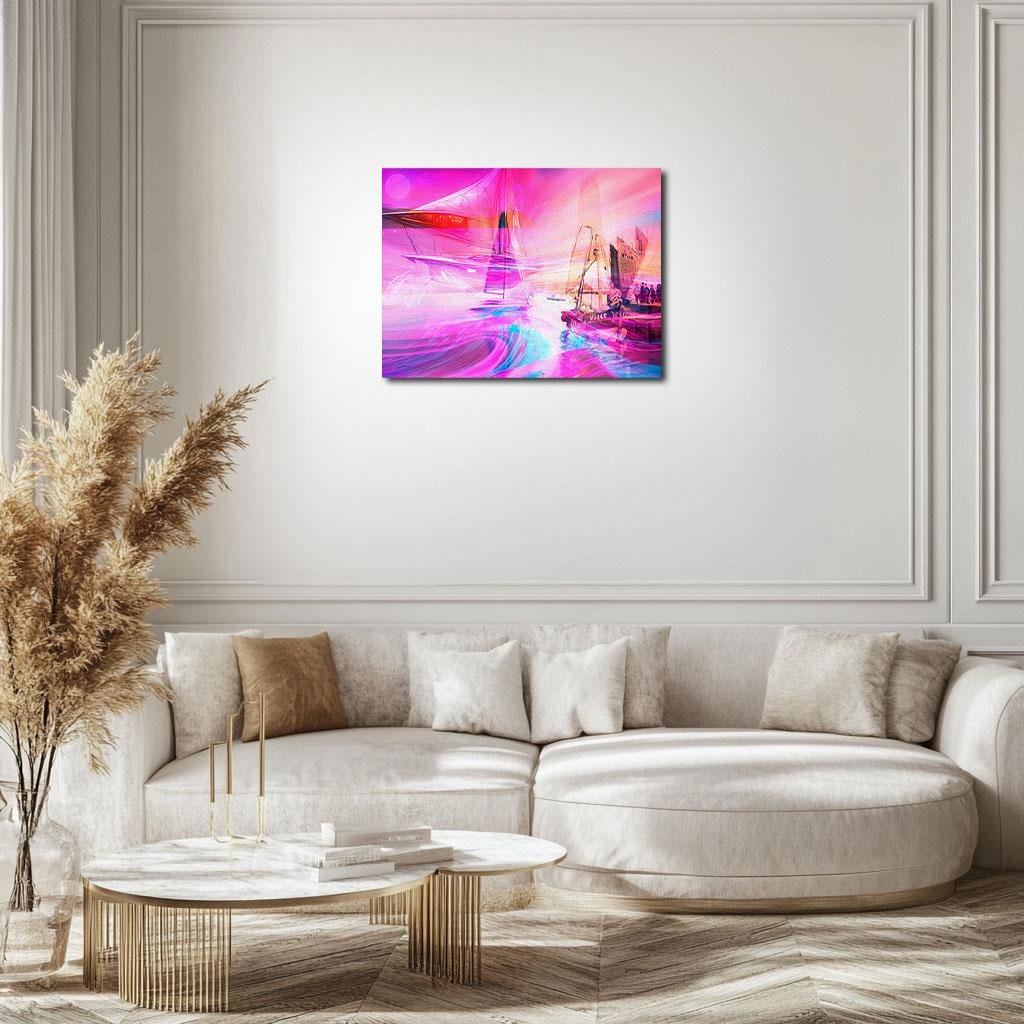Beyond the Sails: Honfleur in the Spectrum of Motion
Beyond the Sails: Honfleur in the Spectrum of Motion reimagines Monet’s 1867 harbor as a luminous ocean of emotion, movement, and color. Traditional boats drift beside futuristic vessels in a surreal sea of magenta and violet light. This digital expressionist piece transforms the calm waters of Honfleur into a vibrant meditation on time, memory, and the eternal motion of vision.
Please see Below for Details…
Hotline Order:
Mon - Fri: 07AM - 06PM
404-872-4663
Claude Monet’s Sailing Boats at Honfleur , painted in 1867, was a gentle reflection of time’s rhythm—boats resting along the Normandy coast, their sails catching the soft winds of a late afternoon. His brushwork, loose and luminous, did not record the sea so much as it recorded the way the sea felt: fluid, constant, always in conversation with the sky. In this digital reinterpretation, titled Beyond the Sails: Honfleur in the Spectrum of Motion , the harbor becomes an ocean of color and energy, where boats no longer glide on water alone, but instead cut through time, memory, and light itself. It is no longer just Honfleur. It is the idea of sailing—unmoored from history and launched into the chromatic breath of dreaming.
The piece opens in a kaleidoscopic storm of pinks, magentas, lavenders, and neon golds. The harbor of Honfleur, with its familiar sailing boats and rustic silhouettes, still holds a corner of the canvas. Wooden hulls etched with the gentle brush of Monet remain visible, tethered to the edge of the dock, with sailors and townsfolk gathered in conversation or labor. But even here, in the far-right corner, the light has begun to shift. The traditional boats glow from beneath with surreal intensity, casting spectral shadows that curl and ripple into surrounding hues. What was once the delicate diffusion of natural light is now a celebration of visual emotion—light as pulse, light as language.
Sweeping across the canvas, the energy grows untamed. The water dissolves into bands of curved motion—violet streaks, cerulean spirals, and iridescent flows wrap around the keels of the boats. The lines are not merely distortions of form—they are directional force. Each movement suggests momentum, transformation. The sea is no longer confined to a surface. It becomes a vertical field, swirling into the atmosphere, bending the entire environment into fluidity.
At the center, a new vessel emerges—unlike any from Monet’s time. A futuristic sailing yacht glides effortlessly, not breaking the surface, but merging with it. Its sleek body, rendered in sharp digital precision, glows with a translucent geometry, its sails stretching upward like wings. The yacht is not an intruder in the scene—it is a continuation. A suggestion of what Honfleur might dream into being if its reflections could evolve into their own desires. The vessel is not anchored. It exists in pure movement, propelled by currents of light rather than wind.
The contrast between the boats of the past and the shape of the future is not a clash. It is a harmony. Each vessel sails through its own temporal current, but both are drawn forward by the same invisible thread—Monet’s sea, reimagined as the medium through which all moments drift. This is no longer a harbor. It is a temporal estuary where history meets speculation, where past and potential sail side by side.
Color functions as narrative here. The dominance of magenta and fuchsia throughout the sky and water conveys passion, intensity, and the inner heat of expression. These are not calm colors. They throb with emotional weight. Electric blue and soft turquoise carve through them like clarity piercing through longing. Golden flares at the edges suggest light sources that are neither sun nor moon, but born of imagination itself. The sky curves above with no clear horizon. It is not sky in the traditional sense. It is a field of becoming, filled with luminous particles and unseen trajectories.
There are no clouds, no birds, no waves as Monet painted them. There is only velocity, immersion, and spectral resonance. The boats do not cast shadows. They radiate energy. They vibrate at the edges, as if caught in a state between being and memory. The traditional is never lost—it is illuminated, magnified, honored through transformation.
As the artist, I approached this piece as a bridge. Not a contrast between then and now, but a fusion of ways of seeing. Monet painted atmosphere with the brush of time—how light moves across form and disappears. This reinterpretation continues that pursuit by stretching atmosphere itself into the subject. The harbor becomes not a place to dock but a place to dream. The sail is not just cloth in wind—it is intent, reaching forward into the unseen.
Beyond the Sails is not just about boats or water or motion. It is about the fluid identity of places, and how the memory of one harbor can become the language of countless journeys. It asks how we carry forward the essence of what we see—not in replication, but in transformation.
Add your review
Your email address will not be published. Required fields are marked *
Please login to write review!
Looks like there are no reviews yet.








